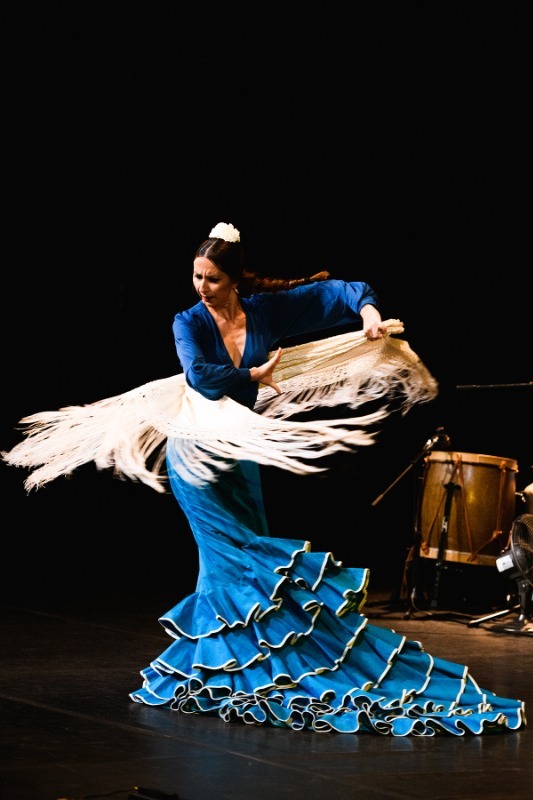

Andrew Liddle, Guest Writer
Flamenco Fireworks Burn Brightest
.jpg)
Lourdes Fernández, Josie Laurel and violinist, Fuensata Zambrana Ruiz. Back to camera, Adrian Sola
Tonight we were privileged to see two of the most accomplished and acclaimed, Lourdes Fernández and Josie Laurel. And what are a few paltry seconds of whizz-bang fire-cracker compared to the sustained beaten tattoo of such bailoras once they have taken the stage!
For one night the Stephen Joseph Theatre’s round had become the Spanish ruedo, the ring where the spectacle takes place. When the lights dimmed, we were suddenly in the sultry land of Carmen and Concierto de Aranjuez and Manuel de Falla’s El Amor Brujo, and above all the mysterious, exotic world of Flamenco.

Lourdes Fernández
(So many times this old jazz critic was reminded of Gil Evans’s discovery when orchestrating Miles Davis’s magnificent Sketches of Spain that Andalusian folk music shares roots with the American Blues and its reliance on African scales.)
First the music, mesmerising in effect, providing the perfect setting for the dance spectacle but absolutely no mere foil for it. The Spanish guitar in the hands (or under the touch, as the Spanish would say) of a master, such as Adrián Solá (also the show's Musical Director and composer), has a palette of tone which is bright, sharp and insistent. The notes hang in the air, resonate and reverberate naturally, are elongated with infinite vibrato before falling away with a sense of melancholy finality. (I think I now better understand where Billie Holiday’s ‘dying fall’ may have come from.)
The violin is not an instrument much associated with it but Fuensanta Zambrana Ruiz’s played an important and beautiful part in creating the sounds of the past that influenced and informed Flamenco. (Again, the jazz critic could not help at times picking up distant strains of jazz manouche, the swing and fret of the Romani gypsies that Django brought us.) The percussionist, Demi García Sabat, who mostly used the palms of his hand, showed a mastery of the full range of rhythms known to the world.
The programme began with some Indian music and dance movements with roots traceable to the Romani people who arrived in the 15th century. The route they took beyond the Indus can only be conjectured but it is likely to have taken them through the Balkans and the second item seems clearly inspired by Hungarian rhythms and melodies.
.jpg)
The Troupe take a bow
After the break, we explored the Caribbean influence (the great Jelly Roll Morton who claimed to have ‘invented’ Jass acknowledged he had given it a Caribbean-Spanish ‘tinge’), in the shape of Cuban creole music. We next hear the echoes of West African drumming music in a spicy upbeat item, probably imported from Cádiz. The penultimate number gloriously locates us on the Argentine pampas where the milonga, the precursor to the tango, comes from.
For much of the time Monica García Macucha sings the words. We sense they are passionate words even if we don’t understand them. She has a noble voice, perfect for the deep soulful expressions of love, life and death in the stories of hardship and suffering she relates in the cante jondo, tempered with the wonders of human warmth and goodness in the lighter cante chico.
Fittingly the evening ends with the joy of classical Flamenco, with a selection of the most frequently performed pieces in the theatres and Flamenco houses of the capital of the province and its expressive art form, Sevilla. Naturally this brought the house down! Who knew there were so many devoted followers of Flamenco in Scarborough.
But, yes, the cynosure of all eyes, centre stage, unfailingly full-on, beautiful to behold in a gorgeous gown and ruffled furbelows, scooping up her long train behind her, fanning them out like peacock feather, flowers in her hair, ramrod stiff back, arms proudly aloft enters the Flamenco dancer, tosses back her head, paws the ground and takes off.
.jpg)
Lourdes takes centre stage
They perform either together, beautifully and impeccably synchronised in their movements, or individually. For much of the time their faces are masks of deep concentration, of high seriousness, of undoubted reverence for their art, their gaze either inward or somewhere in the unfocused middle distance. Then, occasionally, their eyes will shine on some fortunate, momentarily-favoured individual, they will smile seraphically for one stretched second and the world is suddenly a brighter and better place.
You wonder how they can sustain the dance for twenty minutes or more at a time, be so light of foot in their dainty shoes yet clog out so insistent a percussive sound and create such complex rhythms always in time to the music, always graceful in their frenzy.
They stamp with the full foot and it’s a veritable crack. They plant the ball of the foot more softly and expressively. They stab down with the toe-end as if in counterpoint; and they smash with the heel in what looks like - and probably is not - some kind of haughty display of anger. Their legs pump away like pistons and seem to have a life and personality of their own. Their arms are charged with tension or tender with feeling. Their hands open like flowers unfurling and turning to the light.
The narration, ostensibly by the voice of Duende, the personification of fate, the moving spirit that controls our destiny, sets each scene and leads us on our journey through the history of Flamenco.
What a wonderful night this was. Bravo!
.jpg)